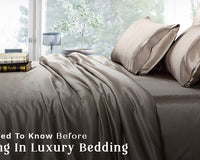Have you ever woken up in the middle of the night feeling uncomfortably hot and clammy, even when your room temperature is just right? If so, your mattress protector might be to blame. While these protective layers are essential for safeguarding your mattress from spills, stains, and allergens, they can sometimes trap heat and moisture — leading to a less-than-pleasant sleeping experience.
This is why breathability in mattress protectors matters more than most people realise. A breathable protector helps regulate temperature, allowing for a cool and comfortable night's sleep. Among the various options on the market, terry fabric mattress protectors stand out for their soft texture, durability, and impressive moisture management. But are they truly breathable? Let’s explore their composition, functionality, and how they compare to other common materials.
Why Breathability Matters in Bedding?
We spend roughly a third of our lives sleeping, so it’s no surprise that our bedding significantly affects our comfort and health. A breathable extra deep mattress protector is crucial in maintaining the ideal sleeping environment. Without it, trapped heat and perspiration can build up, disrupting sleep and causing skin irritation or discomfort.
Terry fabric is well known for its use in towels due to its soft, looped texture and ability to absorb large amounts of moisture. These same qualities make it a smart material for mattress protectors. It balances comfort and practicality, but how does it perform regarding airflow and breathability?
What is Terry Fabric?

Terry fabric is a textile known for its looped pile on one or both sides, contributing to its superior absorbency and plush texture. Originally used in bath linens, it’s now widely used in other household items, including mattress protectors.
Composition of Terry Fabric
Terry fabric is typically made from cotton, polyester, or a cotton-polyester blend. Each version offers slightly different benefits:
-
100% Cotton Terry: Naturally breathable, soft, and absorbent, but may be less durable over time.
-
Polyester Terry: Offers added strength and resilience but may not feel as breathable as cotton.
-
Cotton-Polyester Blends: These provide a great balance of breathability, absorbency, and durability.
This combination of fibres makes terry fabric ideal for bedding, where protection and comfort are key.
The Breathability of Terry Fabric Mattress Protectors
Breathability is the ability of a material to allow air and moisture to pass through it. For mattress protectors, this property ensures heat doesn’t get trapped between your body and the mattress, which can lead to overheating and night sweats.

Terry fabric excels in this area due to its looped texture, which creates tiny pockets that allow airflow. These loops trap and wick away moisture and support ventilation throughout the night.
Additionally, modern waterproof mattress protector often include a breathable waterproof layer, such as TPU (thermoplastic polyurethane). Unlike traditional plastic-backed protectors that feel hot and crinkly, TPU is soft and flexible and allows air circulation while preventing liquid from penetrating the fabric.
The result? A protective barrier that doesn’t compromise comfort — keeping your bed cool, dry, and hygienic.
Comfort and Practical Benefits
Terry fabric mattress protectors go beyond just keeping your bed clean. Here’s how they add practical value and comfort to your sleep routine:
Moisture-Wicking Properties
The high absorbency of terry fabric makes it excellent for wicking away sweat and body moisture. This helps maintain a drier sleeping surface, particularly during warmer months or for those who tend to perspire at night.
By keeping your mattress dry, you also reduce the risk of mould, mildew, and bacteria—all of which thrive in damp conditions.
Hypoallergenic and Skin-Friendly
Many Terry fabric mattress protectors are hypoallergenic, meaning they act as a barrier against common allergens like dust mites, pet dander, and pollen. This makes them ideal for allergy sufferers or anyone with sensitive skin or respiratory issues.
Combined with regular washing, a terry fabric protector can improve your overall bedroom hygiene.
Quiet and Noiseless
Nobody likes the sound of rustling plastic every time they roll over. Unlike some waterproof protectors that make a crinkling noise, terry fabric mattress protectors are remarkably quiet. Their soft surface doesn't interfere with sleep, even if you're restless.
All-Season Versatility
Terry protectors are breathable enough for summer use while adding a slight layer of warmth in colder months. This makes them suitable for year-round comfort.
Comparing Terry Fabric with Other Mattress Protector Materials
When shopping for a mattress protector, it's helpful to compare your options:

Terry Fabric vs. Polyester
Polyester mattress protector are lightweight and durable, often at a lower price. However, they tend to trap heat and may not effectively absorb moisture. Terry fabric offers superior breathability and better moisture management, which translates to more comfort throughout the night.
Terry Fabric vs. Bamboo
Bamboo fabric is another popular option known for its eco-friendliness, natural antibacterial properties, and ultra-soft texture. While bamboo is breathable and comfortable, terry fabric generally wins in absorbency and offers slightly better moisture control, especially when combined with a waterproof backing.
Maintenance and Longevity
One of the standout benefits of terry fabric mattress protectors is how easy they are to care for. Most models are:
-
Machine washable
-
Tumble dryer safe (low heat)
-
Resistant to shrinking or warping
Regular washing (every 1–2 months, or more frequently if needed) helps maintain hygiene, especially for those with allergies, pets, or children.
Tip: Always follow the care label to maintain the waterproof backing and overall integrity of the protector.
Frequently Asked Questions
Q: Are terry fabric mattress protectors suitable for all seasons?
A: Yes, their breathable design makes them ideal for both warm and cool weather. They help keep you cool in summer and add a light layer of warmth in winter.
Q: Will a terry fabric protector fit my mattress properly?
A: Most are available in standard UK sizes, including single, double, king, and super king. Look for fitted-sheet-style designs with elastic edges for a snug and secure fit.
Q: Can I use a terry mattress protector with an electric blanket?
A: Yes, in many cases. However, it’s best to check with the manufacturer to ensure compatibility. Some protectors are designed to be used with electric blankets without compromising safety or comfort.
Q: How long will a terry fabric mattress protector last?
A: With proper care, they can last several years. High-quality protectors that are washed regularly and handled gently tend to maintain their structure and waterproofing longer.
Final Thoughts: Is a Terry Fabric Mattress Protector Right for You?
If you're looking for a breathable, comfortable, and reliable way to protect your mattress, a terry fabric mattress protector is a solid choice. It offers the perfect combination of absorbency, air circulation, and quiet performance, all while helping extend the lifespan of your mattress.
Whether you struggle with night sweats or allergies or just want an extra layer of hygiene and comfort, investing in a Terry fabric mattress protector could transform your sleep.


